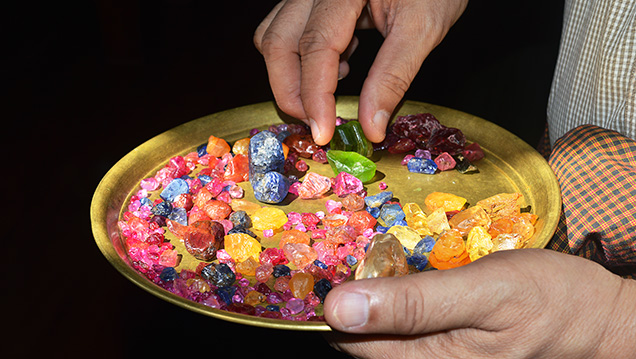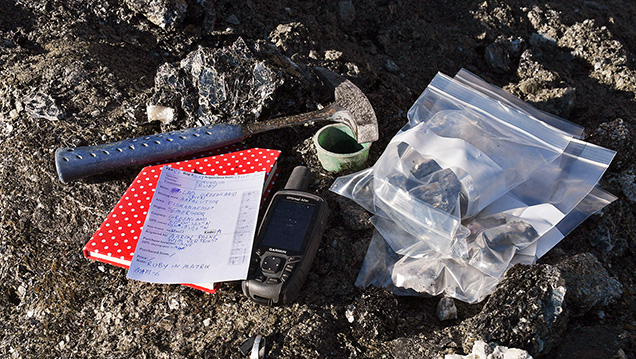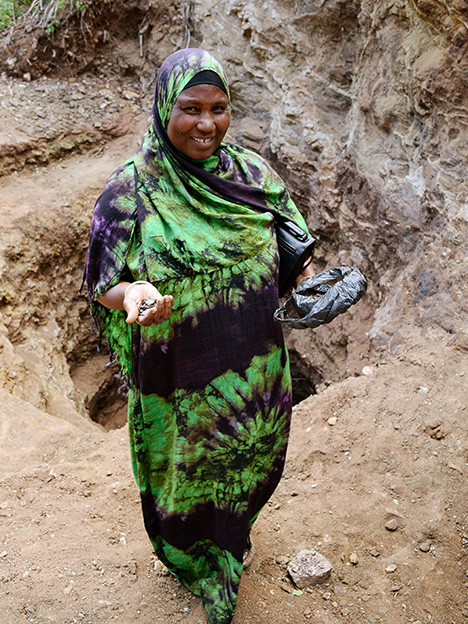General Gemology and Jewelry
Gemstones and Sustainable Livelihoods: From Mines to Markets
Saleem H. Ali
Gemstones and Sustainable Development Knowledge Hub, University of Delaware, Newark
Colored gemstone supply chains are highly fragmented. The large variety of gemstones found in the trade, each with different mining and manufacturing issues and production cycles, adds to this complexity. Yet this fragmentation also creates opportunities for diffuse positive impacts in livelihood formation across the supply chain. Gemstones are predominantly mined through artisanal and small-scale mining (ASM) operations, and many of those who mine the stones remain in poverty. Furthermore, the mining is often undertaken without any mechanism for environmental remediation that can sustain livelihoods beyond the mining phase. In a sector that ranges over 50 producing countries, with a multitude of cultures, environments, and minerals, much research remains to be done on how sustainability can be improved and catalyzed between mines and markets. The benefits that could flow from the sale and beneficiation of colored gemstones remain elusive and often accrue in favor of corrupt interests that could also exacerbate security concerns in fragile states. This sector is a neglected area for research and training and has also largely eluded international mechanisms for accountability such as the United Nations–mandated Kimberley Process for diamonds.
The gemstone industry can play a vital role in sustaining livelihoods and national economies following the cessation of mining. Thailand, formerly a gemstone mining nation, has succeeded in transforming its industrial sector to become the major international hub for the processing (treatment, cutting, and polishing) and trading of gemstones within a few decades. Thailand had a long tradition in gemstone manufacturing and has successfully moved up the gemstone supply chain. The country has achieved this transformation by transmitting know-how, fostering innovation in gemstone refinement, and embodying proactive governance structures. Case lessons like these must be understood and adapted to other geographies as far as realistically possible. The beneficiation of gemstones in their country of origin is a great challenge facing countries across the globe, but especially in Africa. Despite the value and the beauty of the stones, those who mine them and those in the first steps of the value chain often live in poverty. There are encouraging developments—for example, Tanzania has successfully created a gemstone cutting and jewelry-making hub, and the Ethiopian opal sector has had some promising developments in cutting and polishing.
Thus, from mines to markets, colored gemstones provide important opportunities for contributing to development and thereby improving the brand and value of the sector for consumers. However, an integrated mechanism for linking business imperatives with social development dimensions of the sector is essential. This presentation will summarize some of the key research lessons gleaned through the Gemstones and Sustainable Development Knowledge Hub established in 2017 and the nascent educational program that is being developed through a network of international university partners on “Minerals, Materials and Society.”
Challenges of a Twenty-First Century Gem Trader
Edward Boehm
RareSource, Chattanooga, Tennessee
The gem trade looks much different than it did at the end of the last century. Previously the focus was on disclosure of synthetics and treatments, but in the last two decades it has evolved to include greater concern for sustainability, environmental conservation, and transparency in ethical sourcing. Country of origin has always played an important role in high-end gems, and this trend continues today, but the added element of traceability is changing the impact and importance of third-party verification. The country-of-origin pedigree associated with fine-quality gems from sources such as Myanmar (figure 1) and Kashmir has historically translated into desirability and higher value. However, today’s concerned consumer views a country mired in sociopolitical conflict, war, genocide, or terrorism as an undesirable source, potentially leading to boycott by not only consumers but also NGOs and large or publicly traded jewelry companies. These challenges, while daunting, should also be viewed as opportunities for the entire gem trade.

Reputable gem dealers focus on finding quality gems sourced from reliable producers while competing for the best prices. Ethical sourcing is a main focus for many dealers, but recent sustainability and transparency requirements from larger retail chains are adding layers of responsibility that gem traders and gem trade organizations are working diligently to address. The American Gem Trade Association (AGTA), the International Colored Gemstone Association (ICA), and the World Jewellery Confederation (CIBJO) have been leaders in clear communication and disclosure to the consumer. Despite the demands of additional transparency, they face these challenges as opportunities to differentiate themselves by addressing the issues with positive and active policies. Membership in one of these organizations focused on ethical sourcing provides trade professionals with identifiable goals and guidelines to adhere to.
Modern tools to help gem traders adapt to these principles are becoming more available as demand increases. Professionals no longer have to rely only on their own gemological knowledge and contacts. Laboratory reports and now nanotechnology and blockchain tracking all provide potential third-party options for identifying and tracing the flow of gem material. Gemological laboratory reports and recent technological breakthroughs provide avenues for addressing some of the issues facing the trade, but they are not foolproof panaceas for the issues at hand. It will also take active good faith initiatives that involve the entire supply chain, from miners to retailers. As these technologies evolve and others are discovered, the trade will have even more ways to provide accurate information and confidence to consumers.
San Diego Gemstones and Gem Localities
William Larson
Pala International, Fallbrook, California
For over 125 years, San Diego County has produced famous gemstone treasures. This talk will explore the history and famous localities from the original finds of the nineteenth century, as well as the connection to Chinese Empress Dowager Cixi (1835–1908). Her enthusiasm for San Diego gems led to an estimated 90 tons of tourmaline shipped to China before 1910 and the “type” locality finds of kunzite (figure 1) and morganite.

Of special interest, this presentation will detail the revival of San Diego gem mining starting in the 1950s and continuing to this day by looking at the three most important districts: Ramona for spessartine garnet and topaz; Mesa Grande for tourmaline; and Pala for tourmaline, morganite, and kunzite.
The author has been directly involved with 16 gem mining projects in San Diego County since the 1960s and has locally mined 36,000 feet of underground tunnel, resulting in many successful finds. The talk will also delve into current and future challenges for gem mining in San Diego County and elsewhere, including high mining costs—involving governmental, environmental, and safety regulations—and land-use restrictions. Possible bright spots for future gem mining localities include geophysical exploration techniques and underground radar, new mining techniques, and advances in explosives.
GIA’s Field Gemology Program: A Modern Approach to Origin Determination
Wim Vertriest
GIA, Bangkok
Nowadays, origin determination is an undeniable part of gemology. For many high-end colored gemstones, country of origin is considered an important aspect that can significantly influence price. GIA realized early on that delivering trustworthy scientific studies on gemstone origin is a complex affair. It requires advanced technology, well-trained scientists, years of experience, and above all dependable reference samples.
Since the establishment of its field gemology department in 2008, GIA has built and maintained a reliable reference collection. The best way to collect samples is to cut out all intermediaries, thus removing any misinformation, and visit the mining areas in person to collect gemstones at the source, or as close to it as possible. GIA gemologists have observed and documented many of the most important ruby, sapphire, and emerald mining areas over the last decade (figure 1). Over 90 expeditions, over 20,000 reference samples—more than one million carats—have been collected.

The samples collected are integrated into GIA’s colored stone reference collection. Each sample is accompanied by information detailing its sourcing, such as collection date, gem species, known treatment, previous owner details, GPS coordinates of mining and/or buying locations, and purchase price. All the data is subsequently available in an internal database that is accessible to GIA gemologists globally. When data (e.g., inclusion photos, trace-element chemistry, and spectra) are collected on the samples, they are added to the database. This becomes an important resource to GIA colored stone gemologists in every location. In a video on scientific research collections, Sir David Attenborough noted:
a research library associated with collections is almost of greater importance than the objects themselves. Unless you know where it came from exactly, and when it came from exactly, you are missing a lot of very, very important information. That information can not only come from the object itself, but from the circumstances, documentation, that should accompany every scientifically collected specimen.
(“Sir David Attenborough on Museum Collections - 360,” American Museum of Natural History, posted August 31, 2017)
While in the field, GIA team members also document the local situation. This covers mining techniques, trading activity, traditional jewelry making, gemstone history, and local gem cutting. Videos, photos, and interviews are then used to create articles and supplement course content for GIA’s educational programs. In this way, the information gathered during field expeditions becomes an invaluable resource to multiple departments within GIA and serves as a historical record of gem mining sites around the globe.
Closing the Knowledge Gap Across the Supply Chain: A Case Study of GIA and Pact’s Field Collaboration in Tanzania
Cristina Villegas
Mines to Markets Program, Pact, Washington, DC
For years, field gemologists and international development experts across disciplines have noted that colored stone supply chains are lopsided in terms of stakeholder knowledge about stone types, quality and grading, handling know-how, and what happens after the stone leaves the mine and its journey begins in the global jewelry supply chain. Those who mine the stones—typically at great personal risk—are usually the most likely to know the least about them. One stone can change a life if it is of especially high quality, while others may be “tourist grade” (local parlance for lower-value stones). Many artisanal and small-scale miners (ASM) simply do not realize the difference.
In 2017, the Gemological Institute of America and Pact, an international nonprofit social development organization with a specialty in developing and delivering ASM economic and social programs, joined forces to test a simple idea: Can a simple guidebook make a difference, and how?
The project, originally conceived by GIA distinguished research fellow Dr. James Shigley, is part of the Institute’s mission-driven effort to share information and skills throughout the gem and jewelry industry supply chain and with the public. An area in Tanzania’s Umba Valley was identified, and the program rolled out in 2017 with the Tanga chapter of the Tanzania Women Miners Association (TAWOMA; figure 1). The results were fascinating and validated the need for the guidebook. Of particular note: For every $1 the project invested in artisanal and small-scale miners, there was a $12 social return on the investment. Both male and female miners commented that they believe these changes they have experienced will last for more than five years.

This presentation will focus on how the project was implemented, monitored, and measured, and will engage the audience to help identify answers to these questions:
- How can the gemological research sector, and other parts of the jewelry supply chain, help advance local economic and social development agendas in sub-Saharan Africa?
- What other knowledge could be imparted in a context of low literacy? Are there other ways that learning programs could be structured to maximize impact in a given province? In other words, how can we improve in the future and also inspire others to act?
In reporting on her June 2018 trip to the region, the author will provide an update on the 2017 project participants.



